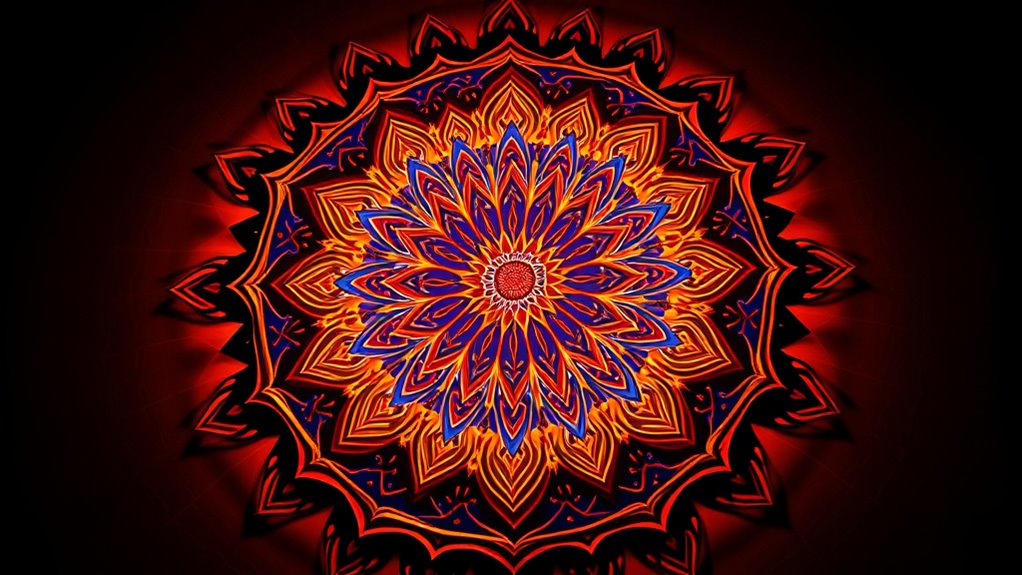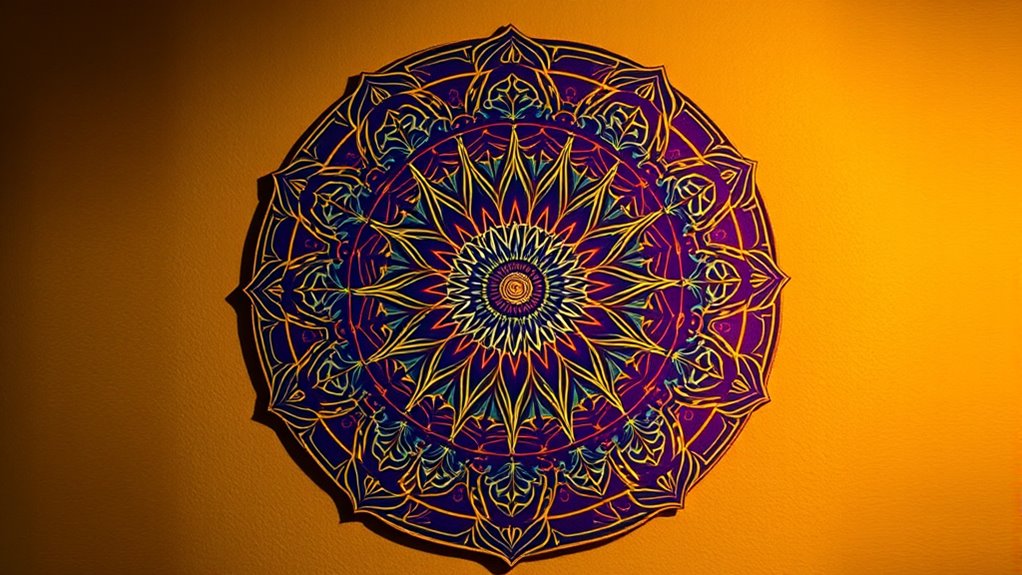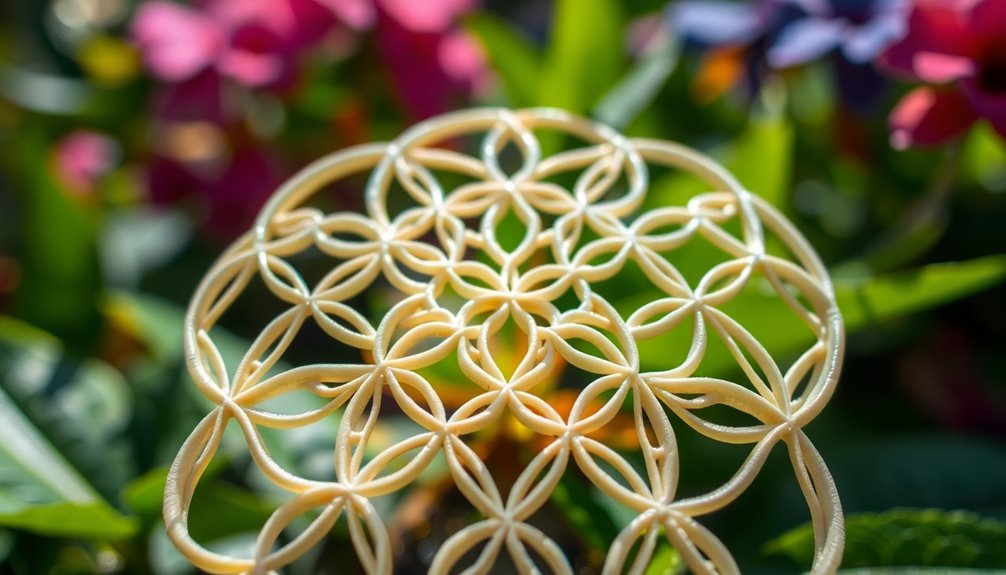Using mandalas for meditation and self-discovery helps you connect with your inner world by engaging with symbolic patterns that promote mindfulness and emotional healing. As you trace, color, or create, you focus your mind, reduce stress, and gain insight into your feelings and subconscious thoughts. This process encourages honest reflection and personal growth, guiding you toward greater harmony within. Keep exploring, and you’ll find even more ways mandalas can support your journey inward.
Key Takeaways
- Creating or coloring mandalas promotes mindfulness, helping focus the mind and reduce stress during meditation.
- Exploring the symbolism in mandalas reveals subconscious thoughts and emotional states, supporting self-discovery.
- Using mandalas as a reflective tool encourages honest self-assessment and personal growth through internal dialogue.
- Engaging with mandalas fosters inner harmony and connection between external expression and internal awareness.
- Incorporating mandalas into meditation practices enhances mental clarity and promotes emotional healing.

Have you ever wondered how intricate patterns can deepen your meditation practice and reveal more about yourself? Mandalas are more than just beautiful designs; they serve as powerful tools for reflection and self-discovery. When you engage with a mandala, you tap into its symbolic meanings, which often represent unity, wholeness, and the universe. These symbols resonate deeply within you, helping to focus your mind and guide your introspection. As you trace the patterns or create your own, you’re not just engaging in creative expression—you’re also decoding layers of your subconscious. Each line, shape, and color can symbolize different aspects of your inner world, giving you insight into your emotions, thoughts, and spiritual state. Incorporating mindful meditation techniques while working with mandalas can amplify their calming and self-awareness benefits. Using mandalas in meditation isn’t about achieving perfection; it’s about connection. The act of coloring or drawing a mandala allows you to channel your energy into something meaningful and personal. This creative expression can be incredibly therapeutic, helping you process feelings that might be difficult to articulate with words alone. As you immerse yourself in this process, you become more aware of your mental landscape, discovering hidden fears, hopes, or desires. The repetitive motions involved in creating or coloring mandalas help quiet your mind, reducing stress and promoting a state of calm. Over time, this practice can strengthen your ability to maintain focus and cultivate mindfulness, making it easier to carry that sense of centeredness into everyday life. Beyond their calming effects, mandalas serve as mirrors of your inner self. The symbols you choose—whether vibrant colors, specific shapes, or complex patterns—reflect your current emotional and spiritual state. By observing these choices, you gain clarity about what’s happening inside you. This process encourages honest self-assessment and growth, helping you identify areas in need of healing or attention. Creating mandalas becomes a dialogue between your conscious intentions and subconscious insights, enabling you to explore parts of yourself that might otherwise remain hidden. In this way, mandalas act as a bridge between the external act of artistic creation and the internal journey of self-awareness. Ultimately, using mandalas for meditation and self-discovery is a deeply personal experience. It invites you to explore your inner world through symbolic meanings and creative expression, fostering a sense of unity within yourself. Whether you’re coloring, drawing, or simply gazing at a mandala, you engage in a meaningful practice that not only calms your mind but also uncover new facets of your identity. As you continue this journey, you’ll find that mandalas become a mirror and a map—guiding you toward greater understanding and inner harmony.
Frequently Asked Questions
Can Children Benefit From Using Mandalas in Meditation?
Yes, children can benefit from using mandalas in meditation. It supports their child development by enhancing focus, creativity, and emotional regulation. Creating and coloring mandalas also serve as a form of art therapy, helping kids express feelings and reduce stress. By engaging in this activity, children develop mindfulness skills that promote mental well-being, making mandalas a valuable tool for nurturing their emotional and cognitive growth.
Are Digital Mandalas Effective for Meditation Purposes?
Digital mandalas can be effective for meditation because their digital designs offer vibrant, customizable visuals that help you maintain visual focus. The ease of access and ability to personalize these images make it simple to incorporate into your practice. As long as you stay attentive to the patterns and use them intentionally, digital mandalas can enhance your meditation, promoting relaxation and self-discovery through engaging visual focus.
How Often Should I Create or Meditate on Mandalas?
You should create or meditate on mandalas as often as your busy schedule allows—ironic, right? Follow your personal routines and listen to what feels right for you. The general frequency guidelines suggest daily or several times a week, but it’s more about quality than quantity. Incorporate mandalas into your routine consistently, and you’ll find deeper self-discovery and relaxation, no matter how often you actually engage with them.
Can Mandalas Help in Overcoming Specific Emotional Challenges?
Yes, mandalas can help you overcome emotional challenges by promoting emotional healing and stress relief. When you focus on creating or meditating with mandalas, you engage in a calming activity that helps you process feelings and reduce anxiety. This mindful practice allows you to gain clarity, release emotional tension, and foster inner peace, making it a powerful tool for addressing specific emotional struggles and supporting your mental well-being.
What Materials Are Best for Creating Physical Mandalas?
Think of creating a mandala like choosing the perfect tools for a masterpiece. You’ll want materials like colored pencils, fine-tip markers, or watercolor paints for vibrant detail, and textured papers or sand for tactile depth. Artistic techniques such as layering, blending, or stippling can enhance your design. The best materials are those that inspire your creativity and suit your style, helping you craft a meaningful, visually mesmerizing mandala.
Conclusion
As you explore mandalas for meditation and self-discovery, you might notice how their intricate patterns seem to mirror your own inner journey. Sometimes, a simple doodle turns into a profound insight, almost as if the universe nudges you along the way. Keep drawing and reflecting—these coincidences could be signs you’re on the right path. Embrace the unexpected connections, and watch how your understanding blossoms in the most surprising and meaningful ways.











